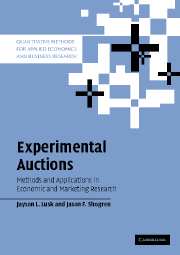Book contents
- Frontmatter
- Contents
- List of figures
- List of tables
- 1 Introduction
- 2 Incentive compatible auctions: theory and evidence
- 3 Value theory
- 4 Conducting experimental auctions: some preliminaries
- 5 Conducting experimental auctions
- 6 Data analysis
- 7 Valuation case studies
- 8 Auction design: case studies
- 9 Validity of experimental auctions
- 10 The future of experimental auctions
- References
- Index
8 - Auction design: case studies
Published online by Cambridge University Press: 27 October 2009
- Frontmatter
- Contents
- List of figures
- List of tables
- 1 Introduction
- 2 Incentive compatible auctions: theory and evidence
- 3 Value theory
- 4 Conducting experimental auctions: some preliminaries
- 5 Conducting experimental auctions
- 6 Data analysis
- 7 Valuation case studies
- 8 Auction design: case studies
- 9 Validity of experimental auctions
- 10 The future of experimental auctions
- References
- Index
Summary
Introduction
Results from experimental auctions frequently generate as many questions as answers about bidding behavior and auction design. Creating an auction that balances experimental control and real-world context can raise fundamental questions about how experience with a good and the market affects bidding, whether preferences are fixed or fungible with different market interaction, how incentive structures can affect bidding behavior, and how hypothetical payments affect bidding behavior. This chapter reports on some of our own work to explore questions of auction design; queries triggered by attempts to value new food products and other basic goods. We focus on eight case studies related to auction design: preference learning, auction institution and the willingness to pay/willingness to accept gap, second price auction tournaments, fixed or fungible preference, gift exchange, calibration of real and hypothetical bidding, and bidding behavior in consequential auctions.
Preference learning
Evidence from experimental auctions suggests the average person will pay a price premium for many new products. But some observers have pointed out that this premium frequently exceeds expectations of what they think people would actually pay in a real retail market. In the case of food safety, for instance, the average person was willing to pay a one-time $0.70 per meal price premium to reduce the health risk from food-borne pathogens – a premium that some observers familiar with the market for safer food believe to be unduly high (Hayes et al., 1995).
- Type
- Chapter
- Information
- Experimental AuctionsMethods and Applications in Economic and Marketing Research, pp. 196 - 246Publisher: Cambridge University PressPrint publication year: 2007



